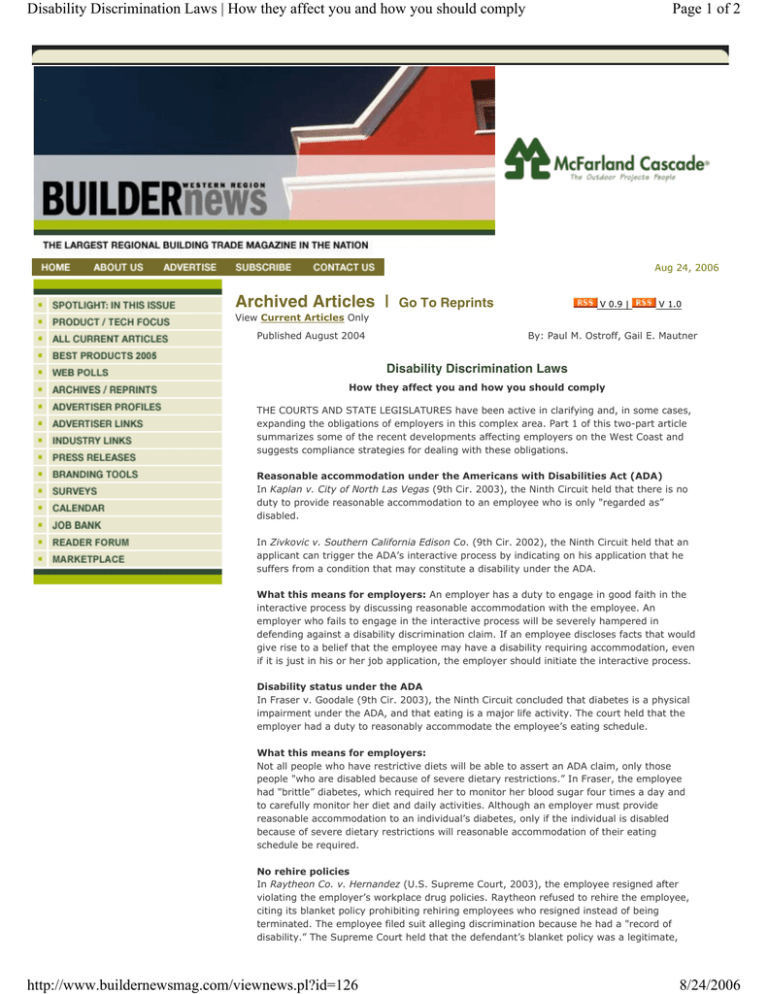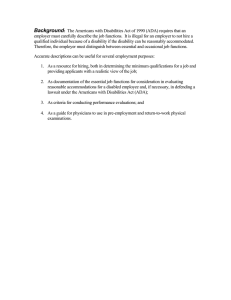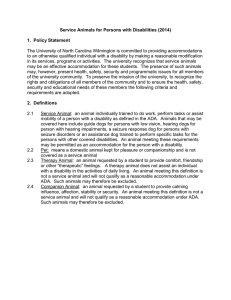Archived Articles | Page 1 of 2 Go To Reprints
advertisement

Disability Discrimination Laws | How they affect you and how you should comply Page 1 of 2 Aug 24, 2006 Archived Articles | Go To Reprints V 0.9 | V 1.0 View Current Articles Only Published August 2004 By: Paul M. Ostroff, Gail E. Mautner Disability Discrimination Laws How they affect you and how you should comply THE COURTS AND STATE LEGISLATURES have been active in clarifying and, in some cases, expanding the obligations of employers in this complex area. Part 1 of this two-part article summarizes some of the recent developments affecting employers on the West Coast and suggests compliance strategies for dealing with these obligations. Reasonable accommodation under the Americans with Disabilities Act (ADA) In Kaplan v. City of North Las Vegas (9th Cir. 2003), the Ninth Circuit held that there is no duty to provide reasonable accommodation to an employee who is only "regarded as” disabled. In Zivkovic v. Southern California Edison Co. (9th Cir. 2002), the Ninth Circuit held that an applicant can trigger the ADA’s interactive process by indicating on his application that he suffers from a condition that may constitute a disability under the ADA. What this means for employers: An employer has a duty to engage in good faith in the interactive process by discussing reasonable accommodation with the employee. An employer who fails to engage in the interactive process will be severely hampered in defending against a disability discrimination claim. If an employee discloses facts that would give rise to a belief that the employee may have a disability requiring accommodation, even if it is just in his or her job application, the employer should initiate the interactive process. Disability status under the ADA In Fraser v. Goodale (9th Cir. 2003), the Ninth Circuit concluded that diabetes is a physical impairment under the ADA, and that eating is a major life activity. The court held that the employer had a duty to reasonably accommodate the employee’s eating schedule. What this means for employers: Not all people who have restrictive diets will be able to assert an ADA claim, only those people "who are disabled because of severe dietary restrictions.” In Fraser, the employee had "brittle” diabetes, which required her to monitor her blood sugar four times a day and to carefully monitor her diet and daily activities. Although an employer must provide reasonable accommodation to an individual’s diabetes, only if the individual is disabled because of severe dietary restrictions will reasonable accommodation of their eating schedule be required. No rehire policies In Raytheon Co. v. Hernandez (U.S. Supreme Court, 2003), the employee resigned after violating the employer’s workplace drug policies. Raytheon refused to rehire the employee, citing its blanket policy prohibiting rehiring employees who resigned instead of being terminated. The employee filed suit alleging discrimination because he had a "record of disability.” The Supreme Court held that the defendant’s blanket policy was a legitimate, http://www.buildernewsmag.com/viewnews.pl?id=126 8/24/2006 Disability Discrimination Laws | How they affect you and how you should comply Page 2 of 2 nondiscriminatory reason to reject the applicant. On remand, the Ninth Circuit found that a reasonable jury could find that Raytheon’s refusal to rehire plaintiff violated the ADA. Specifically, the Ninth Circuit determined that because the defendant had (before refusing rehire) reviewed plaintiff’s personal file, which contained documents showing plaintiff used cocaine and because of Raytheon’s access to past drug tests, there was sufficient evidence for a jury to find that its proffered reason was pretextual. Direct threat defense In Chevron USA, Inc. v. Echazabal (2002), the U.S. Supreme Court held that an employer may refuse to hire an employee whose medical condition creates a direct threat to that employee’s own health or safety. On remand, the Ninth Circuit stated that the determination of whether an individual poses a direct threat "shall be based on an individualized assessment of the individual’s present ability to safely perform the essential functions of the job. This assessment shall be based on a reasonable medical judgment that relies on the most current medical knowledge and/or on the best available objective evidence.” What this means for employers: The apparent direction of the Ninth Circuit in this area is that if an employer is going to deny employment (or a work assignment) to an employee because it imposes a direct threat to his health or safety, there should be substantial medical evidence demonstrating the severity and imminence of the risk. DISCLAIMER: Because of the changing nature of this area of the law and the importance of individual facts, this information is not meant to provide legal opinions and is not a substitute for the advice of legal counsel. Paul M. Ostroff is a partner in the Portland office of Lane Powell Spears Lubersky LLP. He can be reached at ostroffp@lanepowell.com or (503) 778-2122. Gail E. Mautner is a partner in Lane Powell’s Seattle office and a Co-Chair of the firm’s Labor and Employment Department. She can be reached at mautnerg@lanepowell.com or (206) 223-7099. Research assistance provided by Lane Powell associate, Hardeep S. Rekhi. http://www.buildernewsmag.com/viewnews.pl?id=126 8/24/2006




